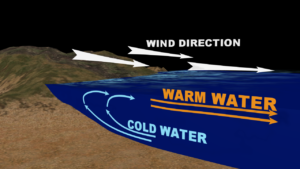 Looks like a great beach day…better check the wind to make sure.
Looks like a great beach day…better check the wind to make sure.
Wind direction mostly, since that can have a drastic effect on conditions on the beach and in the water. When the wind is blowing from the water towards the land you get what is known as a sea breeze. Often times this type of breeze may increase during the afternoon since the land heats up quicker than the water. Warmer land can equal warmer air which rises and is replaced by the cooler air over the ocean. Sea breezes area often desired by the typical beach goer since it will keep temperatures cooler, keep the clouds away, and will even push those annoying black flies inland. When the temperature difference between the land and the water is significant the incoming sea breeze can even take on characteristics of a moderate cold front. Initiating clouds and even thunderstorms as it moves away from the water and over land.
Swing that wind around and you will get what is known (and dreaded in some parts) as a land breeze. With that wind blowing from the land over the water it can create a number of undesirable effects on the sand and in the water. Without the sea breeze then the temperatures can really heat up on the sand and the wind direction can usher in those pesky flies from a back bay or marsh. As the wind blows over the water it moves the warm surface water out only to be replaced by deeper water which is much colder. This is known as up-welling and can drop the coastal water temperature 10 or even 20 degrees. It may not be all bad however. The colder water is full of nutrients and can bring with is some great fishing in the oceans or bays. Large scale up-welling during La Nina years can benefit fisheries up and down the Pacific Coast with the opposite occurring during El Nino years.
This phenomenon is not limited to just oceans and bays. Large lakes can experience up-welling and down-welling with temperatures ranging 20 to 30 degrees from a western and eastern shore. Next time your along a coast notice how the wind direction changes during the day as sea and land breezes fight it out. By checking out that flag on the beach house and noting which direction the wind is blowing, you can get a pretty good idea of what to expect on the sand and in the water.